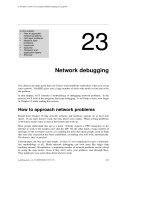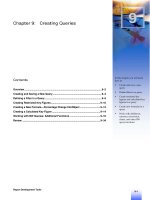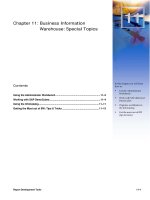Chapter 11 - OSPF CCNA docx
Bạn đang xem bản rút gọn của tài liệu. Xem và tải ngay bản đầy đủ của tài liệu tại đây (1.44 MB, 71 trang )
1
Chapter 11 - OSPF
CCNA Exploration 4.0
Học viện mạng Bách Khoa - Website: www.bkacad.com 2
Objectives
• Describe the background and basic features of OSPF
• Identify and apply the basic OSPF configuration
commands
• Describe, modify and calculate the metric used by
OSPF
• Describe the Designated Router/Backup Designated
Router (DR/BDR) election process in multiaccess
networks
• Describe the uses of additional configuration
commands in OSPF
Học viện mạng Bách Khoa - Website: www.bkacad.com 3
Introduction
Học viện mạng Bách Khoa - Website: www.bkacad.com 4
Background of OSPF
• Began in 1987.
• 1989 OSPFv1 released in RFC 113.
This version was experimental & never deployed
• 1991 OSPFv2 released in RFC 1247.
• 1998 OSPFv2 updated in RFC 2328.
• 1999 OSPFv3 published in RFC 2740.
Introduction to OSPF
Học viện mạng Bách Khoa - Website: www.bkacad.com 5
OSPF Message Encapsulation
• OSPF packet type
– There exist 5 types.
• OSPF packet header
– Router ID.
– Area ID.
– Type code(packet type).
• IP packet header
– Source IP address.
– Destination IP address.
– Protocol field (set to 89 ).
Introduction to OSPF
Học viện mạng Bách Khoa - Website: www.bkacad.com 6
Introduction to OSPF
OSPF Message Encapsulation
• Data link frame header
– Source MAC address.
– Destination MAC address.
Học viện mạng Bách Khoa - Website: www.bkacad.com 7
OSPF Packet Types
OSPF PACKET TYPE DESCRIPTION
1: HELLO Discovers neighbors & builds
ADJACENCY W/ NEIGHBORS
2: DATABASE DESCRIPTION Checks for database synchronization
between routers
3: LINK STATE REQUEST REQUESTS SPECIFIC LINK STATE
DATABASE information from router to
router
4: LINK STATE UPDATE TRANSPORTS LINK STATE records
5: LINK STATE
ACKNOWLEDGEMENT
ACKNOWLEDGES RECEIPT OF other
packet types
Học viện mạng Bách Khoa - Website: www.bkacad.com 8
Hello Protocol
• OSPF Hello Packet
– Purpose of Hello Packet
Discover OSPF neighbors & establish adjacencies.
Advertise guidelines on which routers must agree to
become neighbors.
Used by multi-access networks to elect a designated
router(DR) and a backup designated router(BDR).
Học viện mạng Bách Khoa - Website: www.bkacad.com 9
OSPF Hello Packet
Học viện mạng Bách Khoa - Website: www.bkacad.com 10
• Hello Packets continued
– Router ID of transmitting router.
– Sent every 10 seconds on
multiaccess & point to point serial link.
• OSPF Hello Intervals
– Usually multicast (224.0.0.5).
– Sent every 30 seconds for NBMA
segments.
• OSPF Dead Intervals
– This is the time that must be expired before
the neighbor is considered down.
– Default time is 4 times the hello interval.
OSPF timers
Học viện mạng Bách Khoa - Website: www.bkacad.com 11
DR and BDR
• Hello protocol packets contain information that is used in
electing
– Designated Router (DR)
• DR is responsible for updating all other OSPF routers
– Backup Designated Router (BDR)
• This router takes over DR’s responsibilities if DR fails
Học viện mạng Bách Khoa - Website: www.bkacad.com 12
Introduction to OSPF
OSPF Link-state Updates
• Purpose of a Link State Update (LSU)
– Used to deliver link state advertisements
• Purpose of a Link State Advertisement (LSA)
– Contains information about neighbors & path costs
Học viện mạng Bách Khoa - Website: www.bkacad.com 13
OSPF Algorithm
• OSPF routers build &
maintain link-state database
containing LSA received
from other routers
– Information found in
database is utilized upon
execution of Dijkstra SPF
algorithm.
– SPF algorithm used to
create SPF tree.
– SPF tree used to
populate routing table.
Introduction to OSPF
Học viện mạng Bách Khoa - Website: www.bkacad.com 14
OSPF Administrative Distance
• Default Administrative Distance for OSPF is 110
Học viện mạng Bách Khoa - Website: www.bkacad.com 15
• OSPF Authentication
– Purpose is to encrypt & authenticate routing information
– This is an interface specific configuration.
– Routers will only accept routing information from other
routers that have been configured with the same
password or authentication informa.tion
Introduction to OSPF
Học viện mạng Bách Khoa - Website: www.bkacad.com 16
Basic OSPF configuration
Học viện mạng Bách Khoa - Website: www.bkacad.com 17
Example
Lab Topology
• Topology used for this chapter
– Discontiguous IP addressing scheme.
– Since OSPF is a classless routing protocol the subnet
mask is configured in.
Học viện mạng Bách Khoa - Website: www.bkacad.com 18
Addressing
Học viện mạng Bách Khoa - Website: www.bkacad.com 19
Enable OSPF
The router ospf command
• To enable OSPF on a router use the following command
– R1(config)#router ospf process-id
– Process id
• A locally significant number between 1 and 65535.
• Does not have to match other OSPF routers.
Học viện mạng Bách Khoa - Website: www.bkacad.com 20
Basic OSPF Configuration
• RA(config-router)#network network-address wildcard-
mask area area-id
– wildcard mask - the inverse of the subnet mask
– area-id
• Area-id refers to the OSPF area.
• OSPF area is a group of routers that share link state
information.
Học viện mạng Bách Khoa - Website: www.bkacad.com 21
OSPF Router ID
Find
Router ID
Học viện mạng Bách Khoa - Website: www.bkacad.com 22
Basic OSPF Configuration
OSPF Router ID
• Commands used to verify current router ID
– Show ip protocols.
– Show ip ospf.
– Show ip ospf interface.
Học viện mạng Bách Khoa - Website: www.bkacad.com 23
Basic OSPF Configuration
OSPF Router ID
• Router ID & Loopback addresses
– Highest loopback address will be used as router ID if
router-id command isn’t used.
– Advantage: loopback interface cannot fail OSPF stability
• The OSPF router-id command
– Introduced in IOS 12.0
– Command syntax
• Router(config)#router ospf process-id.
• Router(config-router)#router-id ip-address.
• Modifying the Router ID
– Use the command Router#clear ip ospf process.
Học viện mạng Bách Khoa - Website: www.bkacad.com 24
Show ip ospf neighbor command
• Neighbor ID - The router ID of the neighboring router.
• Pri - The OSPF priority of the interface. This is discussed in a later
section.
• State - The OSPF state of the interface. FULL state means that the
router and its neighbor have identical OSPF link-state databases.
OSPF states are discussed in CCNP.
• Dead Time - The amount of time remaining that the router will wait to
receive an OSPF Hello packet from the neighbor before declaring the
neighbor down. This value is reset when the interface receives a Hello
packet.
• Address - The IP address of the neighbor's interface to which this
router is directly connected.
• Interface - The interface on which this router has formed adjacency
with the neighbor.
Học viện mạng Bách Khoa - Website: www.bkacad.com 25
Basic OSPF Configuration
Verifying OSPF
• Use the show ip ospf command to verify & trouble shoot
OSPF networks
• Neighbor adjacency
– No adjacency indicated by
• Neighboring router’s Router ID is not displayed.
• A state of full is not displayed.
– Consequence of no adjacency
• No link state information exchanged.
• Inaccurate SPF trees & routing tables.









